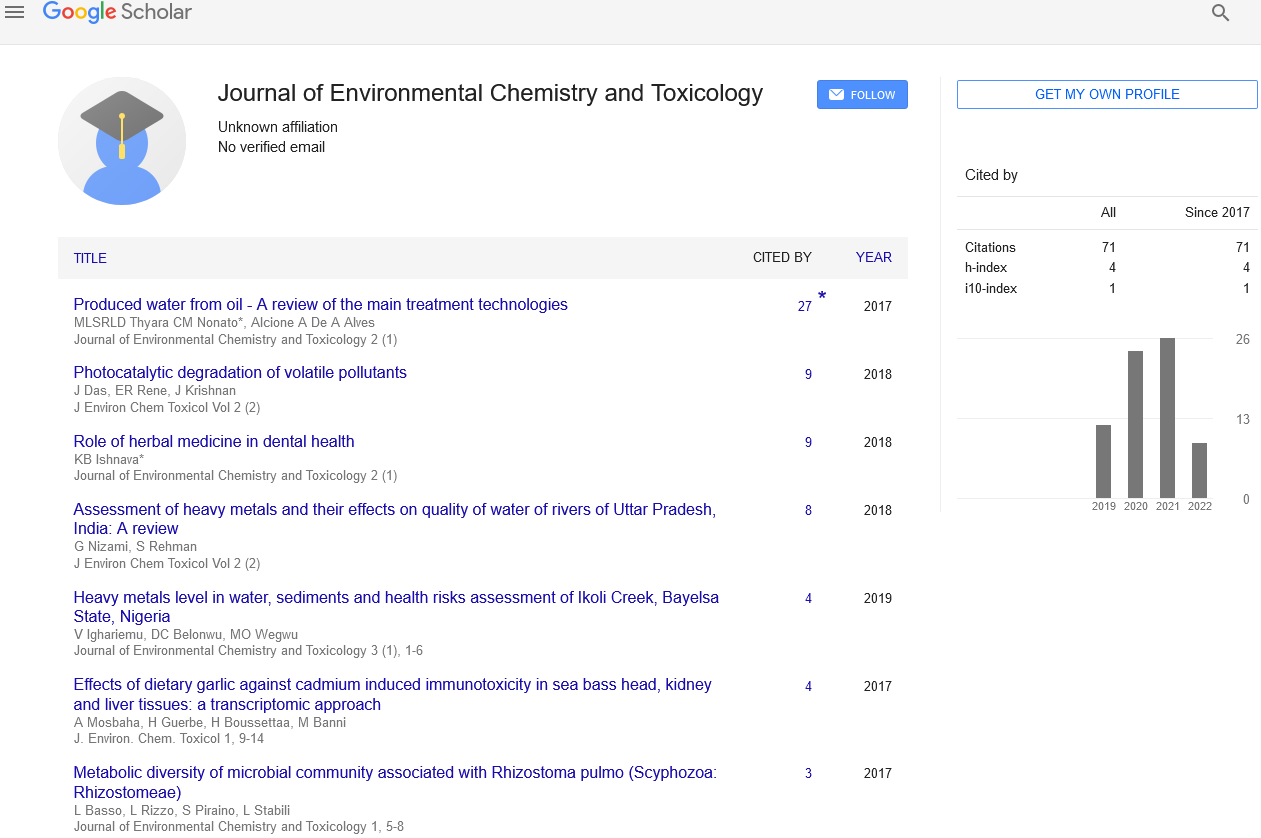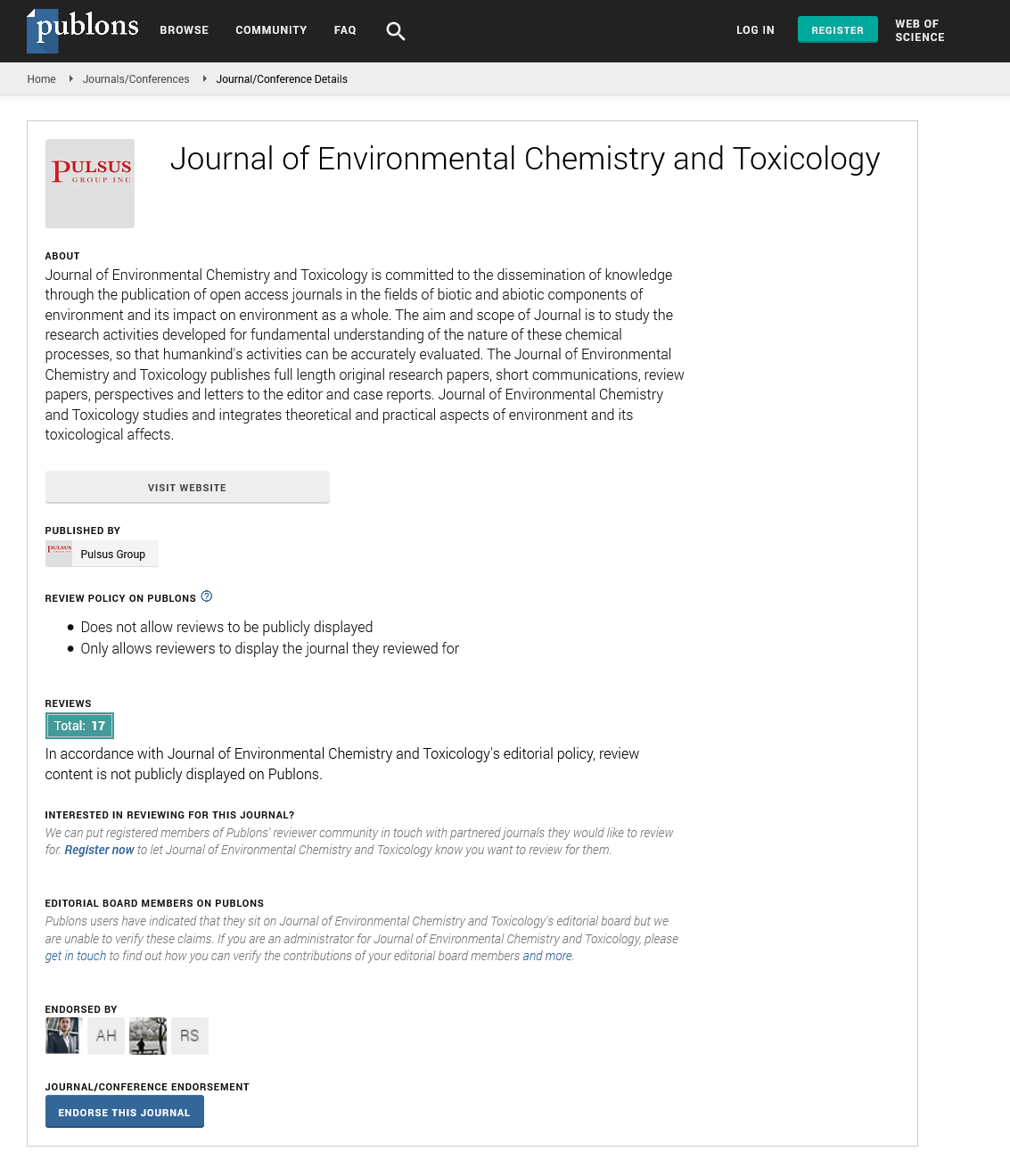Role of herbal medicine in dental health
Received: 26-Dec-2017 Accepted Date: Feb 02, 2018; Published: 12-Mar-2018
Citation: Ishnava KB. Role of herbal medicine in dental health. J Environ Chem Toxicol. 2018;2(1):28-9
This open-access article is distributed under the terms of the Creative Commons Attribution Non-Commercial License (CC BY-NC) (http://creativecommons.org/licenses/by-nc/4.0/), which permits reuse, distribution and reproduction of the article, provided that the original work is properly cited and the reuse is restricted to noncommercial purposes. For commercial reuse, contact reprints@pulsus.com
Abstract
Dental disease is one of the globally affecting diseases. Herbal medicine is effective because they interact with specific chemical receptors within the body. Herbal medicines have less side-effect in comparison with traditional medicines. There is lack of information about the effect of herbal medicine treatments on dental health. Herbal medicine treatment in dental diseases they are used as antibacterial agents, anti-inflammatory agents, and sedative and anxiolytics. The natural phytochemical could offer an effective to antibiotics and represent approach to prevention and therapeutic strategies for
various dental diseases. Plants active against dental organisms has been listed and this review highlight the role of herbal medicinal and phytochemicals like flavanoids, polyphenols, terpenes, alkaloids in the treatment of dental health and infections associated with dental care. The purpose of this review is to present some recent examples of herbal medicine or phytochemicals that have been shown to inhibit the growth of oral pathogens, reduce the development of dental plaque, and reduce the symptoms of dental diseases. It indicates that plants have the potential to generate herbal medicine.
Dental diseases are among the major public health problems in the global level affect mankind. The oral cavity is inhabited by microbial species and many intrinsic and extrinsic factors affect the composition, pathogenicity and metabolic activity and of the highly diversified oral microbial flora responsible [1]. Oral bacteria involved in the bloodstream have been linked to coronary artery disease, atherosclerosis and stroke [2]. Dental disease main characteristic is destruction of supporting tissue of the tooth by microbial oral biofilm. Dental health is integral to general wellbeing and relates to the quality of life that extends beyond the functions of the craniofacial complex [3]. Antibiotic like tetracyclines and metronidazole, antiseptic like chlorhexidine have been use very long time but many side effects observed [4]. The effective alternative to antibiotics and represent a promising result to prevention and therapeutic strategies for various dental diseases. The herbal medicine has an edge over conventional antibiotic treatment that suffer the limitation of low benefit to high risk as compared to herbal treatment that possess high benefit to low-risk ratio. Herbal medicine with medicinal properties has been used for long period to prevent and treatment of different disease of dental disease [5]. The major problem is the lack of the information and traditional knowledge about effects of medicine on dental disease. This reason urgent needed to the reviewing this information for researcher to help the focusing the herbal medicine in dental diseases treatment. Herbal medicine may vary in their effectiveness; therefore, it is necessary to select herbal medicine very carefully. Herbal medicine and their extract can be used as adjuvant in dental disease treatment. The present review of the last few years’ development of the herbal medicine used as alternative medicine of dental diseases treatment.
Dental diseases are still consideration as serial public health problems and major burden to health care services around the world. Periodontal disease impairs glycemic control in people with diabetes, and poorly controlled diabetes may exacerbate periodontal disease [6]. Aspiration of oropharyngeal secretions is the predominant cause of nosocomial pneumonia in elderly persons. For example, bacterial resistances to most of the antibiotics commonly used to treat oral infections are penicillin’s and cephalosporins, erythromycin, tetracycline and derivatives and metronidazole. Herbs have been used for centuries to prevent and control dental disease. Herbal extracts are effective because they interact with specific chemical receptors within the body. The following herbal medicine reported in the last few years.
Different dental diseases treatable with herbal medicine are common in traditional health practice namely: dental caries, toothache, gingivitis, ulcerative gingivitis, mouth ulcers, swollen tonsil, oral thrush, tonsillitis and black tongue [7]. Zingiber officinalis present the various components of ginger are 1-4% essential oil and an oleoresin, zingiberene, curcumin, sesqui phellandrene, bisabolene. It is used to relieve toothache, as a sialogog, in the treatment of oral thrush. Ginger may reduce the toxic effects of the chemotherapeutic agent cyclophosphamide [8]. Eucalyptus globules, hexane and ethyl acetate extracts found highly effective against, Lactobacillus acidophilus with MIC value of 0.031 and 0.062 mg/mL, respectively. Qualitative phytochemical investigation of above extracts showed the presence of alkaloids, phenolic compounds, steroids, cardiac glycosides and terpenes. The investigation on the structure elucidation of the bioactive compound presents the alpha-farnesene, a sesquiterpene. Eucalyptus globules plant leaf extracts have great potential as anti-cariogenic agents that may be useful in the treatment of oral disease [9]. Jain et al. [10] reported the Aloe vera gel at optimum concentrations in toothpastes or mouthwashes could be useful for prevention of periodontal diseases and dental caries. Syzygium aromaticum gel can provide dentists with an alternative to benzocaine for topical anesthesia in their daily practice, especially for use with children and in areas where cost and availability limit access to pharmaceutical topical anesthetics. It is available as a tincture (1:5, 25% ethanol), lozenges and mouthwash [11]. The kinetic study showed that Streblus asper completely inactivated C. albicans at the concentration 50 μg/ml in 15 h. Haemolytic activities of the Streblus asper plant leaf protein gives HC50 value at a very high range than that of the MIC values against Candida albicans of the organisms and thus flourish its application as successful pharmaceutical drug in practice [12].
Bhattacharyaa et al. [13] reported the MIC values for Staphylococcus aureus and Streptococcus pyogenes against Mimusops elengi seed protein extract are 364.36 μg/ml and 182.19 μg/ml, respectively. Kinetic study further elucidates the mode of inhibition in the presence of the Mimusops elengi plant seed protein in context to time. The concentration of crude extract which gave 50% hemolysis compared to Triton X-100 treatment (HC50) value was 1.58 mg/ ml which is more than five time larger than that of the MIC. Treatment with proteinase K of the Mimusops elengi seed protein results in absence of the inhibition zone which clearly indicates the activity was only due to protein. Mimusops elengi seed protein extract is useful for the dental disease for anti-carcinogenic activity. Indrani Bhattacharya et al. [13] reported the good inhibitory potential of hexanolic and ethyl acetate extracts of Piper betle plants against Candida albicans and panel of cariogenic bacteria will be useful in the future development of effective formulations of drugs for the control of human oral pathogens. Bhoot and Ishnava [14] reported the formulation of essential oils of Neem, Eucalyptus, Tulsi, Lemongrass, Palmrosa, Clove and Punica. The formulations No. 10 and 13 showed strong antimicrobial activities with MIC ≥ 0.2 mg/ml against C. albicans. The result shows that oils at different concentrations exhibited anti-microbial activity against dental pathogens. These materials could be served as an important natural alternative to prevent bacterial growth in dental diseases. Hexane extract of Mimusops elengi L. and Punica granarum L. seed against Candida albicans and Streptococcus pyogenes. Plant seed extracts have great source as anti-cariogenic compound against oral pathogenic microorganisms, which can be used to treat infectious diseases [15].
Conclusion
Herbal medicine has great source as oral diseases curing compound against dental diseases, which can be used to treat dental diseases. Herbal medicine, as alternative method of curing dental diseases, has day by day increasing demand in the developed country of the world. Herbal medicine and their product have been used as adjuvants in dental disease treatment because the reducing the side effects of comparing the antibiotics. Herbal medicine product in dental disease has a great potential, but it is challenging to determine the side effect and toxicity proper checking of herbal medicine and their product.
Acknowledgement
Authors are thankful to Charutar Vidya Mandal (CVM), Vallabh Vidyanagar and Director of Ashok and Rita Patel Institute of Integrated Studies and Research in Biotechnology and Allied Sciences (ARIBAS), New Vallabh Vidyanagar, Gujarat, India for providing necessary support for research and laboratory facility.
REFERENCES
- Aniebo MC, Odoemelam HA, Okonko IO. Isolation and identification of Candida albicans and Staphylococcus aureus from oral swabs among primary school pupils in Uzuakoli, Abia State, Nigeria. Nat Sci. 2012;10(8):9-16.
- Beck JD, Garcia R, Heiss G, et al. Periodontal disease and cardiovascular disease. J Periodontol. 1996;67:1123-37.
- Petkovic MS, Kesic LG, Kitic DV, et al. Periodontal disease and phytotherapy. Org Hyg Health. 2015;3:1.
- Taheri JB, Azimi S, Rafieian N, et al. Herbs in dentistry. Int Dent J. 2011;61:287-96.
- Kumar G, Jalaluddin M, Rout P, et al. Emerging trends of herbal care in dentistry. J Clin Diagn Res. 2013;7:1827-9.
- Hollist NA. Collection of traditional Yoruba oral and dental medicaments. Olubena Printers, Ibadan. Nigeria, 2004.
- Sudarshan GR, Vijayabala S. Role of ginger in medicine and dentistry-An interesting review article. Southeast Asian J Case Rep Rev. 2012;1:66-72.
- Ishnava KB, Chauhan JB, Barad MB. Anti-cariogenic and phytochemical evaluation of Eucalyptus globules Labill, Saudi. J Biol Sci. 2013;20:69-74.
- Subhash AV, Suneela S, Anuradha C, et al. The role of Aloe vera in various fields of medicine and dentistry. J Orofac Sci. 2014;6:5-9.
- Jain N, Rajwar YC, Batra M, et al. Dentistry: Turning towards herbal Alternatives: A review. Scholars Journal of Applied Medical Sciences. 2014;2(1C):253-7.
- Soni H, Ishnava K, Patel K. Anti-cariogenic activity and hemolytic study of some medicinal plants leaf extract against six oral pathogens in in vitro condition. Int J Appl Sci Biotechnol. 2014;2(3):253-9.
- Ishnava KB, Shah PP. Anti-cariogenic and hemolytic activity of selected seed protein extracts in vitro condition. J Dent. 2016;11(5):576-86.
- Bhattacharyaa I, Ishnava K, Chauhana J. In vitro anti-cariogenic activity of some Indian medicinal plants towards human oral pathogen. Asian J Tradit Med. 2016;11(4):88-98.
- Bhoot N, Ishnava KB. Antimicrobial activity of medicinally important essential oils against selected dental microorganisms. Int J Curr Microbiol App Sci. 2016;6(6):1562-75.
- Rajput D, Kalpesh I. Anti-cariogenic activity of some Indian medicinal plants. Eur J Dent Educ. 2016;9(1):1-8.






